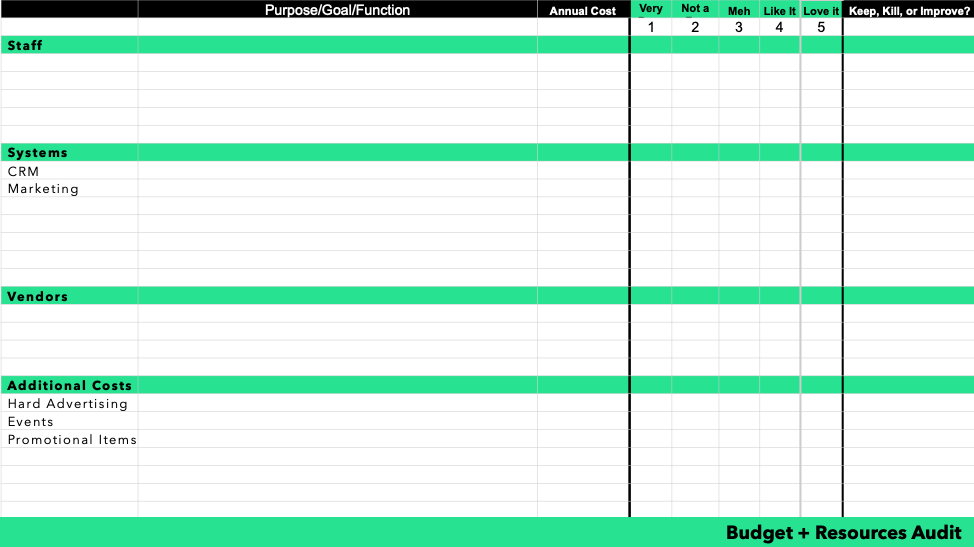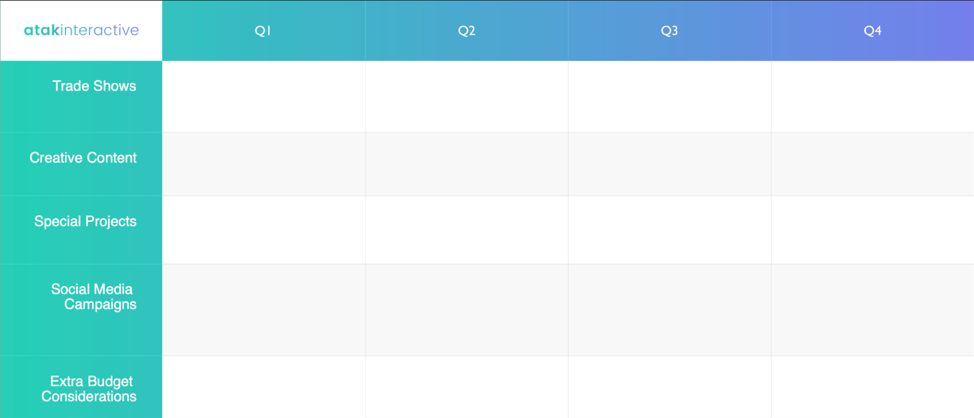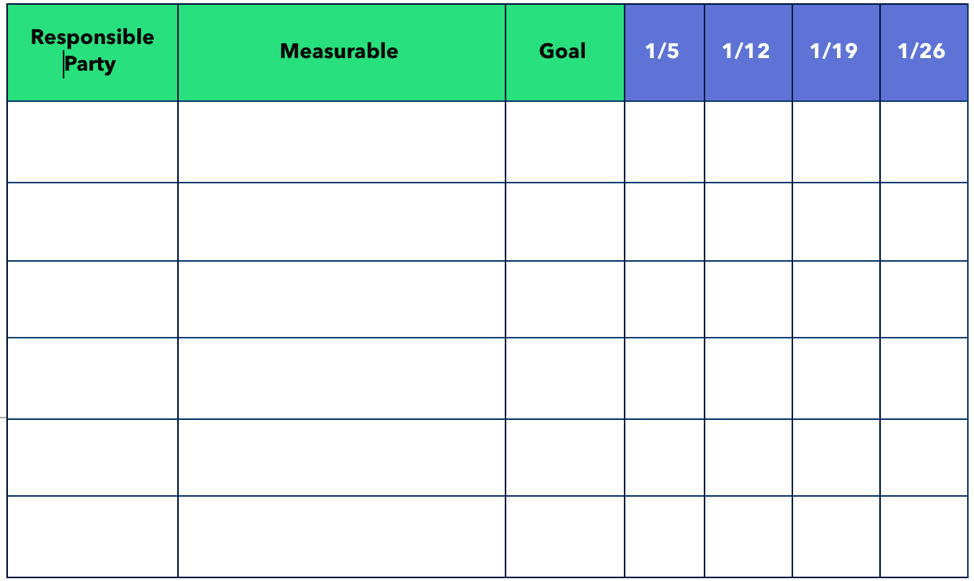7 Ways to Build a Winning B2B Marketing Plan for 2021
7 Ways to Build a Winning B2B Marketing Plan for 2021
Whether it’s in our personal or professional lives, the end of each year brings on a duality of reflection and promise. We get to evaluate how our 2020 was fulfilled relative to how we forecasted it while also developing the strategic plans for 2021 that will get us where we want to be this time next year. Regardless of how your company’s marketing efforts performed over the past 12 months, you have every opportunity to make 2021 a successful year.
In over 15 years working with clients on their strategic planning, I’ve noticed a theme to our end-of-the-year planning sessions: we spend a lot of our time brainstorming the creative elements of campaigns. What if this was our campaign slogan!?!? How great would a video be where Jack tells the competition to stuff it?!?! You get the idea.
The key to good strategic planning, however, is setting your “follow-through” up for success. Everybody has good ideas, but what do they mean if you can’t execute on them?
This is a seven-step process for your annual planning that I promise will allow you to be creative, but also organize your efforts in a way that’s manageable and sets your accountability up for success.
Step One: Create + Finalize Your Budget
One of the most simple, effective exercises in Purposeful Marketing is the Customer List Analysis. If you follow the simple steps, a series of calculations help you identify important data points from a one year period:
- Gross Revenue
- Average Customer Value
- Average New Customer Value
- Cost-Per-Acquisition
- Return on Investment
- Customer Value Per Revenue Stream
- Customer Value Per Acquisition Channel
- Customer Value Per Persona
Having these data points handy makes it easy to recognize where past efforts have worked and where others may not have been as successful as desired. This is a small, albeit vital part of building a marketing budget. Let the data give you a starting point.
Next, do a Budget + Resources Audit. Here’s a simple format you can use:

Be as thorough as possible and identify how your staff, systems, vendors, and additional efforts performed. Make sure you identify their purpose/goal/function. Sometimes, you have the right purpose but you’re spending money on the wrong actions. That’s okay, if the purpose is clear, you can always shift budget and activity to something new that is still serving the same function.
With calculations and evaluations complete, it’s time to build a budget.
There are two paths you can go from here, it just depends on your circumstances. The biggest goal of building a budget is to create a dollar figure that can be identified as your lowest possible annual spend. With that, you can break the numbers down quarterly, monthly, and weekly from there. In path one, you take last year’s calculations, your evaluations, and your current financial situation and determine your lowest possible marketing budget figure for the entire year. This is a simple step that many companies skip. They want to go straight to the breakdown before committing to a floor. Give yourself the floor.
In path two, we take it further and really get to the nitty-gritty. An easy way to do this is to duplicate the same sheet as above, and delete all of the columns after “Annual Budget”. If you keep the format concise and work more on the annual figures, you won’t waste time trying to project spend for a specific project you want to do 10 months from now. Keep it high level and allow your team or agency to help you maximize the allocated funds you’ve determined will get you where you wish to be.
Step Two: Develop a Macro Calendar
I know what you’re thinking – what the heck is a “macro” calendar? A macro calendar is built to serve as an overarching guide to your upcoming year. Take a look at the template below:

On the left, you have five examples of important themes for the company. Above, you have them separated by quarters, helping illustrate the broad outlook for the year.
Each company should create its own 5-7 categories they need to monitor and implement into the first column on the left. Every company is different, but a few considerations may be:
- Trade Shows/Events
- Creative Content
- Special Projects
- Social Media Campaigns
- Extra Budget Considerations
- Seasonal Promotions
- Budget
- Important Dates
Regardless of the categories that define your company, a general plan should be laid out for each quarter. The purpose is to develop an outline for the year and fill in the details for each quarter as you go. This symbiotic relationship between the big picture and 90-day goals will help you balance your vision for the year with the immediate work ahead.
Step Three: Build a Weekly Scorecard
I say it all the time – data dictates behavior. Case in point – I recently lost 20 pounds. It’s probably the fifth time in my life I have had to lose a good amount of weight. When things are good and I am not too concerned with where I’m at, I may step on the scale one time in six months. When I want to get slim, I look at that damn scale every single day. If it doesn’t tell me what I want, I eat better, run the extra mile, or swim an extra ten laps. The data pushes me to go where I want to be.
A scorecard for a business is no different. By identifying metrics that need to be tracked, reviewed, and reacted to on a weekly basis, you’re letting the numbers drive your organization.
If you need a reminder, this is what a scorecard looks like:

Three self-explanatory columns: 1) who’s responsible, 2) the metric you’re tracking and 3) the weekly goal. To the right, you insert your actual performance metrics and measure them against the weekly goal. It’s a straightforward but effective process.
If you’re not keeping a scorecard, there’s no better time than the start of a new year to begin. If you are currently utilizing a scorecard, make sure your metrics and goals are correct and adjust accordingly.
Step Four: Determine Your 2021 KPIs
Knowing the right numbers to look at weekly is a great first step towards getting more out of the data component of your business. The next step is to create tangible KPIs for the year that those numbers fill into. For instance, if you determine that you want “15 New A+ Customers” as your annual goal, your scorecard should be documenting the amount of A+ leads coming in each week.
When developing these KPIs, two things are very important:
- Quality over quantity. Anything more than 6 KPIs for the year muddies the vision. If you’re having trouble narrowing it down, list each of them and decide to either “keep, combine, or kill” until you’ve got your core goals for the year.
- Make them S.M.A.R.T Goals (specific, measurable, achievable, realistic, timely). Replace language like “Improve our closing rate” with “Bring in 6 new customers for every 10 leads we identify as SQLs.”
Once you’ve gotten these straight and your team is on the same page, do one last double-check on your scorecard to make sure your weekly goals are feeding into your annual KPIs accurately.
Step Five: Determine Q1 Initiatives
Okay, we’ve painted the broad strokes of what we want the year to look like. We have a calendar, we have goals, and we have weekly numbers we have to hit. Now it’s time to recognize what our priorities are and sprint towards getting them done.
The first thing the marketing group needs to identify is the top five accomplishments they want to achieve as a team that quarter. Once there is consensus, each of these accomplishments needs to have a Team Lead who owns getting this task completed and who will be reviewed on this at the end of the quarter.
Once you have decided on the Q1 initiatives for the team, consider breaking down each member’s top five individual goals for the quarter as well.
Note that this is (still) not yet time to be creative. This can make preparing goals a little tricky, but it’s not too difficult to navigate. For instance, if you realize you need to install a series of HubSpot workflows this quarter, it’s okay to create a quarterly initiative called “Install 3 HubSpot workflows signed off on by the management team” before determining the creative for the campaign, the triggers, etc.
And one last tip for the pros – once you create these monthly initiatives, break them down into two-week checkpoints. Using our workflow example above, determine what you need to do in the first two weeks of the quarter to keep your initiative on track and ready to roll.
Step Six: Identify Amplifiers
Whether it be strategic partners, industry media, current clients, or thought leaders your company is friendly with, there are undoubtedly key stakeholders in your center of influence that can amplify any campaigns, products, or newsworthy events.
Create that list. Break down these “amplifiers” into categories such as:
- Clients
- Industry Editorial
- Strategic Partners
- Vendors
- Industry Thought Leaders
- Business Leaders that You Network with
- Industry Advertising
- Digital Advertising
If you’re going to try to do something with the intention of getting attention, you need to know who the specific people and entities who can help you spread the word. Create a central spreadsheet that can be added and subtracted from throughout the year. Identify if you actually have any relationships with these people or strategy/budget for advertising.
Having a clear understanding of your center of influence – who they are, how you reach them, where you stand with them, will help you integrate this list into your quarterly initiatives.
Step Seven: Get Creative, Get Unique
Well, we made it! You put in the leg work to actually make a plan that holds you accountable. Now it’s time to have some fun.
Have each person in your marketing team bring 3 ideas to the table of creative work you can use for advertising campaigns, content offers, events, etc. Stay within reason – if you’re a $10m company don’t suggest producing a Super Bowl commercial. Let everybody pitch one idea at a time and set a timer for each idea that can be discussed.
Use what we call “the rule of improv” during the brainstorming session. When someone pitches an idea, all responses should begin with “yes, and…”. Take the ideas as far as they can go, and each person should rate each idea once its hit time. The rating should be based more on plausibility and perceived effectiveness, not giving brownie points for the “most creative,” but rather, the ideas that can fuel your marketing campaigns and help you hit your 2021 KPIs.
If you know it’s time for your marketing operation to get organized and get set up for success from an accountability standpoint, book an introductory call with ATAK’s CEO, Austin LaRoche, today!



